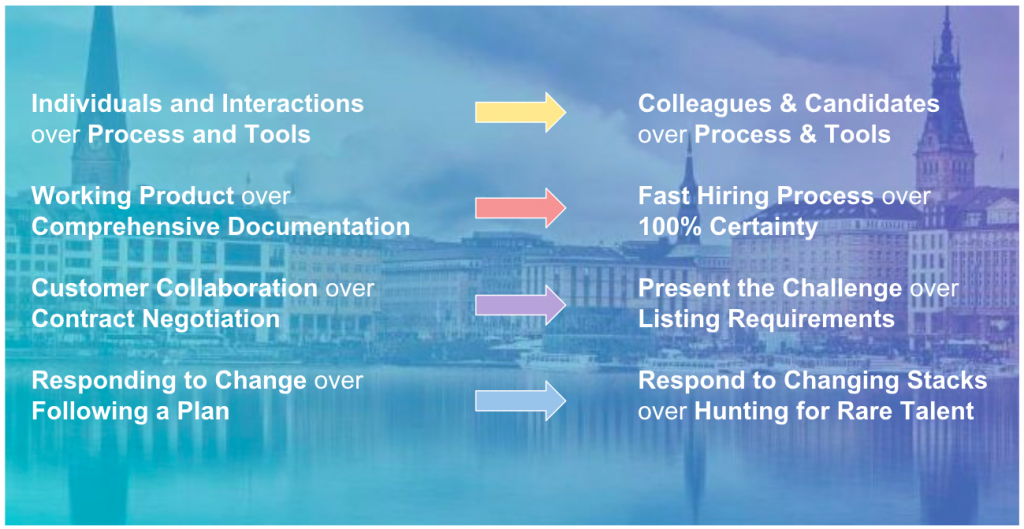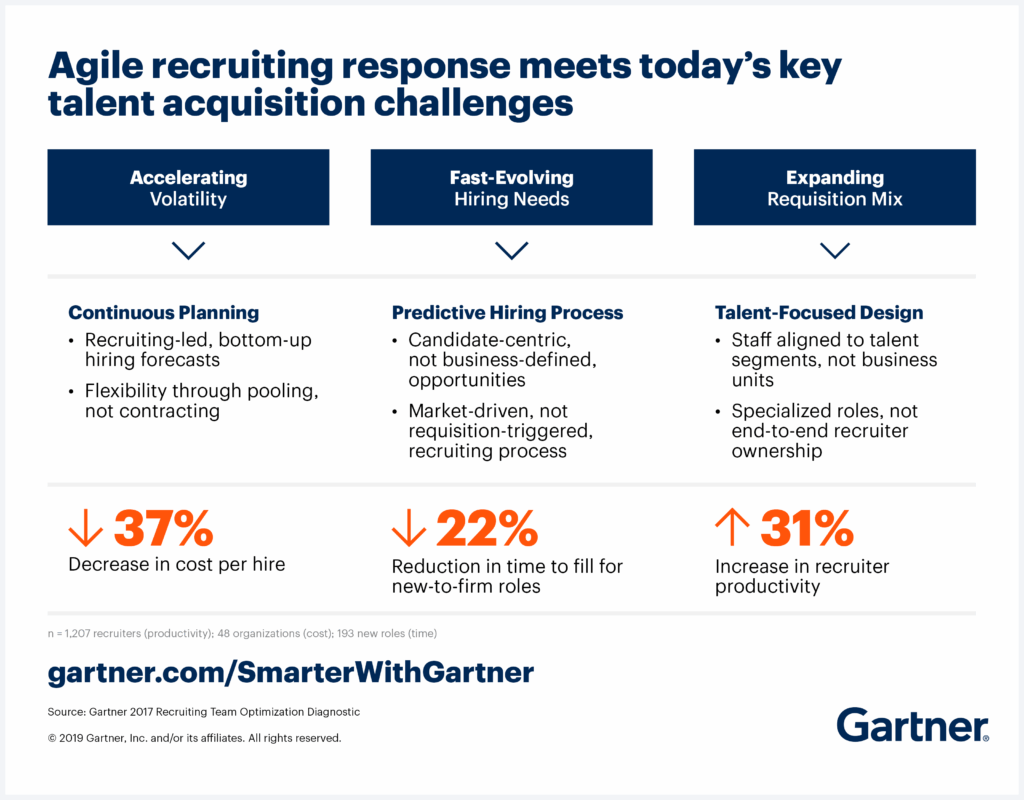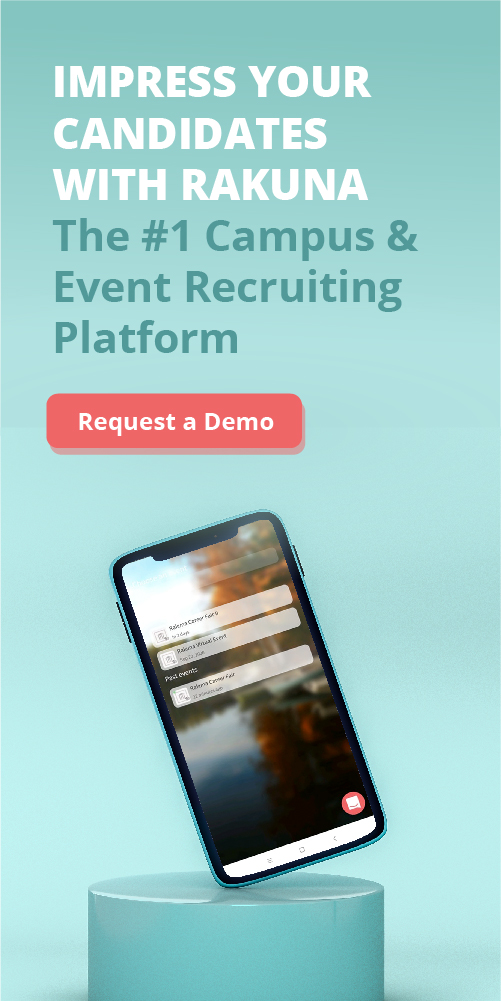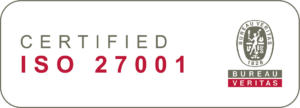The world of work is in constant flux. Market volatility, evolving candidate expectations, and the rise of remote/hybrid models demand more than just traditional recruitment tactics. We’ve all felt the pressure: rising costs, fierce competition for top talent, and the need to fill roles faster without sacrificing quality.
But within these challenges lies a significant opportunity. This dynamic environment pushes us towards building more empowered, trust-based team cultures. It necessitates new ways of working that drive efficiency and results.
For talent acquisition professionals, flexibility isn’t just nice-to-have; it’s fundamental to success.
This is where Agile Recruiting emerges as a powerful framework. Borrowing proven principles from agile methodologies, it provides a foundation for better prioritizing hiring needs, fostering seamless team collaboration, and creating a more effective, responsive, and candidate-centric talent acquisition process. If you’re looking to build a winning recruitment function, understanding Agile is key.
I. What is Agile Recruiting?
From The Buzzing Word In the Technology Industry
You’ve likely heard the term “Agile” – it originated with the Agile Manifesto in 2001, primarily for software development. The core idea wasn’t just about speed; it emphasized collaboration, responding to change, delivering value incrementally, and continuous improvement. Think of it as a philosophy for getting high-quality work done effectively in complex, fast-moving environments.
These principles resonated far beyond tech. Business leaders quickly recognized their value, and Agile methodologies spread across functions like marketing, manufacturing, and, crucially, Human Resources. As Harvard Business Review noted, Agile isn’t just a process; it’s become a critical capability for organizational success.
In essence, business agility means an organization can:
- Adapt swiftly to market shifts (both internal and external).
- Respond rapidly and flexibly to customer (and candidate!) demands.
- Navigate change productively and cost-effectively while maintaining quality.
- Foster innovation and continuous improvement.
- Maintain a competitive advantage in the talent market.
In the 17th State of Agile Report, findings indicate that 71% of 788 respondents use Agile in their work process, specifically the software development lifecycle.
Furthermore, research confirms the trend: McKinsey found that fully agile organizations can respond to changing market dynamics 5x faster than traditional ones.
To the next trend for modern recruiting professionals
So, what does this mean for us as recruiters? Agile Recruiting takes these core principles – adaptability, collaboration, iterative progress, data-driven decisions – and applies them directly to the talent acquisition lifecycle.
In simple terms, Agile Recruiting involves:
- Breaking Down large hiring projects (like filling multiple roles or a complex position) into smaller, manageable pieces or tasks.
- Structuring work in short, focused cycles called “sprints” (typically lasting 1-4 weeks).
- Prioritizing tasks based on immediate hiring needs and value.
- Emphasizing collaboration between recruiters, sourcers, coordinators, and hiring managers.
- Creating frequent feedback loops to learn, adjust, and improve the process as you go.
Instead of getting lost in a long, linear recruitment process, Agile allows modern recruiters to tackle smaller sets of tasks with clearer deadlines. These short cycles naturally create more opportunities for feedback, reflection, and course correction, increasing flexibility, efficiency, and visibility for everyone involved. The specific application varies, but common elements include continuous planning, predictive hiring insights, and a talent-centric design.
II. The Tangible Benefits: Why Adopt Agile Recruitment?
Adopting an agile approach isn’t just about following a trend; it delivers measurable advantages:
Benefit 1: Accelerate Your Time-to-Hire
- How it works: Sprints force focus. By tackling hiring needs in short, defined cycles (e.g., 2-4 weeks), recruiters can concentrate efforts on the most critical tasks for a specific set of roles. This iterative approach allows for quicker assessment of what’s working and what isn’t.
- The Impact: Imagine the traditional average time-to-fill often cited around 36-42 days (source: SHRM benchmarks vary). While a single sprint might be shorter, the overall process velocity increases through focused effort and rapid adaptation. Companies implementing agile recruiting often report significant reductions in time-to-fill, sometimes by as much as 20-40% for certain roles, because bottlenecks are identified and addressed faster. This speed is crucial – top candidates aren’t on the market for long. A faster process means fewer drop-offs and a higher chance of securing star talent. This also boosts recruiter morale through faster, tangible results.
Benefit 2: Leverage Continuous Feedback & Adaptation
- How it works: Agile builds in regular check-ins (like daily stand-ups or weekly sprint reviews). These aren’t lengthy status meetings; they’re quick touchpoints designed for sharing progress, identifying roadblocks, and gathering real-time feedback from hiring managers and team members.
- The Impact: If sourcing strategies aren’t yielding the right candidates, or if a job description isn’t attracting the desired pool, you know within days or a week, not after a month of wasted effort. This allows for rapid pivots – refining search strings, adjusting outreach messaging, or clarifying requirements with the hiring manager before significant time is lost. It enables the team to proactively implement new insights or tools mid-process.
Benefit 3: Boost Collaboration and Team Empowerment
- How it works: Agile prioritizes interactions and collaboration over rigid processes. It often involves creating cross-functional “sprint teams” (e.g., a recruiter, sourcer, and coordinator focused on a specific set of roles) working closely with hiring managers.
- The Impact: This breaks down traditional silos. Recruiters aren’t just order-takers; they become strategic partners collaborating deeply with hiring managers. This shared ownership and transparent workflow (often visualized on a shared board) fosters trust and encourages proactive problem-solving. Empowering teams to adapt their workflow within the sprint framework fuels motivation and improves overall team performance. Studies on agile team dynamics frequently point to increased engagement and productivity due to higher autonomy and clearer shared goals.
III. Implementing Agile Recruiting: A Practical 5-Step Guide
Ready to try Agile? Remember, this is a framework, not a rigid prescription. Adapt it to your unique context. While the standard approach involves continuous planning and talent-focused design, think of Agile as a philosophy you customize. Here’s a suggested starting point:
Step 1: Define the Needs & Assess Readiness
- Review Current State: Before diving in, honestly assess your team’s resources, current hiring processes, technology stack, and overall hiring strategy. Where are the biggest pain points? Which roles cause the most delays or frustration?
- Identify Pilot Projects: Agile often works best initially for complex, niche, high-volume, or poorly understood roles where requirements might evolve. Don’t try to change everything overnight. Select a specific area for a pilot.
- Stakeholder Alignment: Hold focused kick-off meetings with key hiring managers. Go beyond a standard job description. Collaboratively define roles based on performance objectives (What must the person achieve in the first 6-12 months?) and the Employee Value Proposition (EVP) (Why would a top candidate choose this role at this company?). This clarity is foundational.
Step 2: Assemble Your Agile Recruiting Team (Using Scrum Concepts)
Many teams adopt elements of Scrum, a popular Agile framework. A dedicated “Recruiting Scrum Team” looks different from a traditional structure:
- Scrum Master (Process Facilitator & Protector): This person champions the Agile process. They facilitate meetings (like daily stand-ups and retrospectives), help remove obstacles blocking the team’s progress, and ensure the team adheres to the agreed-upon Agile practices. They protect the team from external disruptions during a sprint. Think of them as the team’s coach and process guardian.
- Project Owner (Hiring Goal Champion): Often a senior recruiter or recruiting manager, this role represents the “voice of the customer” (hiring managers, business needs). They are responsible for defining and prioritizing the Recruitment Backlog (the master list of all hiring needs/tasks) and ensuring the team is working on the most valuable items. They define the ‘what’ and ‘why’.
- Recruitment Team (Talent Finders & Engagers): These are the professionals doing the core recruiting work within the sprint cycle – sourcers, recruiters, coordinators. Ideally, this is a small, cross-functional team possessing all the skills needed to move candidates from identification to offer within the sprint’s scope. They figure out the ‘how’.
💡 Note: Smaller teams (e.g., 3-7 people) focused on a specific goal tend to be more effective in an Agile setup.
Step 3: Create a Plan and Visualize Progress (Kanban)
- Build the Backlog: The Project Owner works with stakeholders to create the Recruitment Backlog – a prioritized list of all roles to be filled and related tasks.
- Sprint Planning: At the start of each sprint (e.g., every 2 weeks), the entire Recruiting Scrum Team selects a set of high-priority items from the backlog they commit to completing within that sprint. They define a clear sprint goal and outline how they will achieve it.
- Visualize the Workflow (Kanban): Transparency is key. Use a physical whiteboard or a digital tool (like Trello, Jira, Asana, or specialized ATS features) to create a Kanban board. This visualizes the workflow stages. Simple columns might be:
Backlog | Sprint Goal | To Do (This Sprint) | Sourcing | Screening | Interviewing | Offer | Done. Tasks (often on sticky notes or digital cards) move across the board as they progress. This makes bottlenecks instantly visible and keeps everyone aligned.
Step 4: Establish Metrics and Leverage Technology
- Measure What Matters: Define key metrics to track per sprint. Examples include:
✅ Time-to-fill (for roles completed within the sprint)
✅ Number of qualified candidates presented per role
✅ Candidate-to-interview ratio
✅ Hiring manager satisfaction score (quick pulse checks)
✅ Candidate experience feedback (short surveys)
- Tech Enablement: Use your ATS, CRM, and collaboration tools to support the Agile process. Automate administrative tasks, standardize communication templates, use analytics dashboards to track metrics, and facilitate seamless team communication. Technology should enable agility, not dictate process rigidly.
Step 5: Sprint, Reflect, Adapt, Repeat
Agile is iterative. The cycle involves consistent routines:
- Daily Stand-ups: Quick (10-15 min) daily meetings where each team member briefly shares: What did I complete yesterday? What will I work on today? Are there any impediments? This keeps the team synced and surfaces blockers fast.
- Sprint Review: At the end of the sprint, the team demonstrates the work completed (e.g., presents qualified candidates, discusses progress on roles) to stakeholders (Project Owner, hiring managers). This is about showing results and gathering feedback on the outcome.
- Sprint Retrospective: Also at the end of the sprint, the Recruiting Scrum Team meets internally to reflect on the process. What went well during the sprint? What challenges did we face? What can we improve in the next sprint? This commitment to continuous improvement is the engine of Agile.
Based on feedback and reflection, adjust the backlog, refine processes, and start the next sprint cycle.
IV. Agile Recruitment in Action: Success Stories
With a long history of nearly 130 years, GE has continuously made bold moves to stay relevant in an ever-changing market. It started its reinventing journey in Human Resources with the introduction of RaaS, a new agile model for recruiting.
GE’s RaaS framework for agile recruitment was built based on the Scrum framework mentioned earlier with four key elements:
- The Recruiting Scrum Team: GE’s team is built as a cross-functional team focused on the execution and delivery of 2 to 5-week sprint cycles. They have all the needed skills to complete any backlog item.
- The Recruiting Scrum Master: A new role in the recruiting industry to facilitate scrum in the organization and shield the team from interruptions.
- The Headcount Owner: This person represents all hiring managers’ voices to organize the hiring backlogs and set priorities for each job order.
- Technology: A one-stop talent platform connecting talent pipelines, skills, technical assessments, and headcount backlogs. It also feeds a Kanban board to visualize the working process and enable progress visibility to all stakeholders.
This Agile Recruiting model allows GE to enable a fully immersive experience for the candidates.
Talented people don’t get lost and confused in the process, especially when not matched to a specific position. Plus, coordination between team members also got a lot better since information flows fluidly, and members can share information about candidates who may fit in more than one role.
By adapting to this agile model, GE continues to drive innovation and maintains its industry leader position.
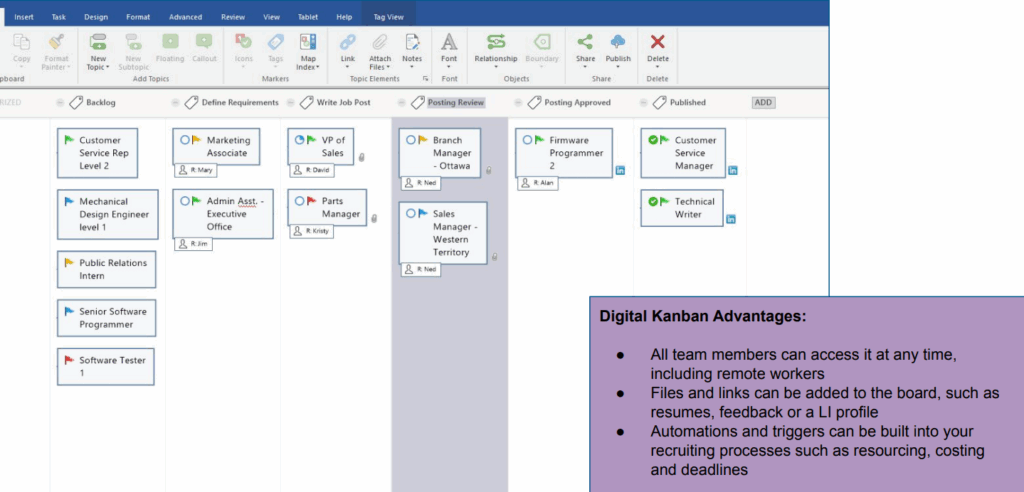
Deezer‘s problem: Deezer did not harmonize its recruitment process between business units. As its team doubled after one year, many positions were opened, which resulted in too much back-and-forth communication and not good candidates’ experience.
Deezer’s Action: The recruitment and engineering teams teamed up to change the situation. Their application of Kanban for HR is part of a series of initiatives to enhance the collaboration between the HR/Recruitment team and engineering teams.
So what did Deezer’s HR team do?
- Step 01: Setting the goals: Deezer’s team goals were assembling the right team and addressing candidates’ pain points, including creating explicit processes, measurable metrics, and better reporting.
- Step 02: Preparation: They asked for support from the HR Director to implement new initiatives. They also mapped a clear picture of the current recruitment process, which they would analyze to make proper changes.
- Step 03: Applying Kanban board: At the first cycle, Deezer had 2 specific Kanban boards called the Job Board and Candidate board. The job-based board gave them an overview of all opened jobs, while the candidate-based board was to track candidates through the recruitment process.
- Step 04: Testing and improving after each iteration: After each iteration, they reflected on their setup, identified improving points, and moved to the next iteration.
To Conclude…
Agile Recruiting methodology is not perfect and not an ex-Machina that works in every recruiting situation.
Recruiters also need to understand that agile recruitment is not about taking shortcuts, despite how it can be done by the book. Agile recruitment is not an excuse to skip building quality relationships with candidates.
On the contrary, it’s a way to approach the mission differently by splitting the overall big goals into approachable tickets and tackling them efficiently, with plenty of space for setbacks, iterations, collaboration, and improvements along the way. If you want to research more about Agile development, check out this informative article by TCGen.

Team Rakuna
The Rakuna Team comprises a diverse group of professionals hailing from various corners of the world.
With a passion to enable organizations to hire their next waves of talents, we are dedicated to help organizations stay updated on important recruiting technology and industry best practices.

